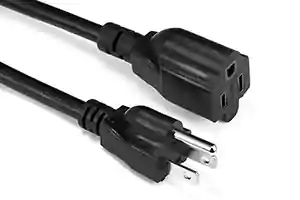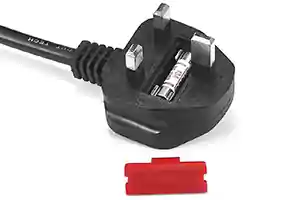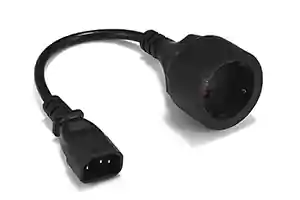Popularly known as the Europlug, the Type C plug is a 2 pin unearthed plug used throughout continental Europe, parts of the Middle East, and much of Africa, South America, Central Asia, and the former Soviet republics.

Table of Contents
What Type of plug is a Type C plug?
Type C plug is the most widely used plug internationally. This two-wire plug is ungrounded, unpolarised, and has two round prongs. It is popularly known as the Europlug which is described in CEE 7/16. The electrical plug has two 4 mm round pins, measuring 19 mm in length on centers spaced 18.6 mm apart at the base and 17.5 mm apart at the tip.
The two pins have 10 mm long insulated sleeves. They converge slightly, but they are relatively flexible, allowing the plug to mate with any socket that accepts 4.0 – 4.8 mm round contacts on 17.5 – 19 mm centers. The plug is generally limited for class II applications requiring 2.5 amps or less.
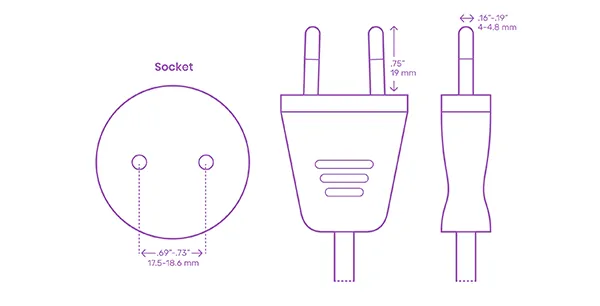
There is also a second, less frequently used version of the Type C plug (CEE 7/17), which is rated at either 10 A or 16 A. Its pins have the same length (19 mm) as the 2.5 amp version, but they are not insulated and have a slightly larger diameter (4.8 mm instead of 4 mm). Appliances that do not require earthing but are high energy-consuming are almost always fitted with this kind of plug (e.g. hairdryers, bathroom heaters, vacuum cleaners, etc.).
Please note that type N sockets, which are used in Brazil and South Africa, are incompatible with the 16 amp version of type C because of the shape of the plug. Type N sockets are recessed and hexagonally shaped and only accept hexagonally-shaped plugs.
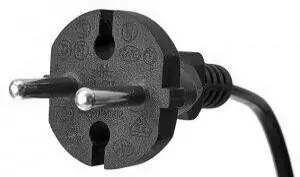
Type C plug features
The Type C plug is the CEE 7/16 (Europlug 2.5 A/250 V unearthed). A similar plug with slightly larger pins is known as the CEE 7/17. Both types are unearthed and have two round pins which converge slightly. The CEE 7/16 is intended for devices that require 2.5 A or less. The 19 mm separation of the pins and the pins’ 4 mm length allows safe insertion in most Type C, Type E, Type F, Type H, and some Type L outlets.
The larger CEE 7/17 has a round plastic or rubber base that prevents it from being inserted into small sockets. The base has holes to accommodate the side contacts and socket earth pins.
What countries use Type C plug?
Type C plug is commonly used in all countries of Europe except in the United Kingdom, Ireland, Malta, and Cyprus. They are also used in various parts of the developing world.
Albania
Algeria
Angola
Argentina
Austria
Azores
Balearic Islands
Bangladesh
Belgium
Bolivia
Bosnia
Brazil
Bulgaria
Burkina Faso
Burundi
Cameroon
Canary Islands
Cape Verde
The central African Republic
Channel Islands
Chile
Comoros
Congo
Croatia
Dem. Rep. of Congo (Zaire)
Cote d’Ivoire (Ivory Coast)
Cyprus
Denmark
Djibouti
Egypt
El Salvador
Equatorial Guinea
Eritrea
Faeroe Islands
Finland
French Guiana
Gabon
Germany
Gibraltar
Greece
Greenland
Guadeloupe
Guinea
Guinea-Bissau
Hungary, Iceland
India
Indonesia
Iran
Iraq
Isle of Man
Israel
Italy
Kazakhstan
Korea
Kuwait
Laos
Lebanon
Lithuania
Luxembourg
Macedonia
Madagascar
Madeira
Mali
Martinique
Mauritania
Mauritius
Monaco
Montenegro
Morocco
Mozambique
Myanmar
Nepal
Netherlands
Niger
Norway
Oman
Pakistan
Paraguay
Peru
Philippines
Poland
Portugal
Romania
Russia
Rwanda
St. Vincent
Senegal
Serbia
Slovenia,
Somalia
Spain
Sudan
Suriname
Sweden
Switzerland
Syria
Thailand
Togo
Tunisia
Turkey
Uruguay
Vietnam
Zambia
Electricity Type C plug certificate
INMETRO and CSA agency approvals and certifications are available on the product specification page, IEC Type C Plug.
We have made a very detailed graphic introduction in the article safety marks for more information about the safety certification of power cord plugs.
What about Type C sockets?
Although type C plugs are used in so many places worldwide, the opposite is true for type C sockets. This socket is the older and ungrounded variant of Type E, F, J, K, L, N, and O socket. Nowadays, most countries demand grounded sockets to be installed in new buildings.
Since type C sockets are unearthed, they have become illegal almost everywhere, and they are being replaced by type E, F, H, J, K, L, N, or O (depending on the country). To leave no doubt: only the sockets have become illegal, the plugs remain in use, of course. The ‘normal’, 2.5 amp type C plug fits perfectly into a type E, F, H, J, K, L, N, or O socket.
Now It’s Your Turn
So that’s how I understand Type C plug and socket.
Now I want to turn it over to you: Through my article, do you understand Type C Plugs and Sockets (Outlets)?
Do you have a different point of view with the power plug type C? Or any other questions?
Let me know by leaving a quick comment below right now.
